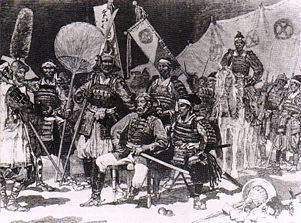Saigo Takamori
Saigō Takamori (西郷 隆盛 Saigō Takamori, 23 January 1827/28 - 24 September 1877), one of the most influential samurai in Japanese history, lived during the late Edo Period and early Meiji Era. As a low-ranking samurai, he was recruited to travel to Edo, modern day Tokyo, to assist Shimazu Nariakira, daimyo of Satsuma han. He was later put in command of over fifty thousand samurai, a large part of the Imperial Army.
Boshin War (1868-69)
As a leader of the Imperial forces in the Boshin War, Saigō was one of the key figures in the Meiji Restoration. In spite of his humble background, he became the state councilor and army general of the new state.
Seikanron debate (1873)
Saigō initially disagreed with the modernization of Japan and the opening of commerce with the West. He famously opposed the construction of a railway network, insisting that money should rather be spent on military modernization.[1]
He did insist, however, that Japan should go to war with Korea because of the Koreans' refusal to recognise the legitimacy of the Emperor Meiji as head of state of the Empire of Japan. But because the other leaders of the restoration strongly opposed these plans out of budgetary and cost considerations, Saigō resigned and returned to his hometown of Kagoshima.
Satsuma Rebellion (1877)

Shortly thereafter, he established a private academy in Kagoshima for the faithful samurai that had also resigned their posts in order to follow him from Tokyo. In 1877, led by Saigō, they revolted against the central government (the Satsuma Rebellion), which had just eliminated their rice stipends. The imperial palace had recruited new guards who had previously been rice-growing peasants. They were armed with modern weapons. The samurai, also being equipped with modern weapons, were able to seriously challenge the imperial army in battle for several months. Badly injured in the hip during the final battle, the Battle of Shiroyama, instead of being killed or captured by the enemy, Saigō asked for his head to be cut off by a comrade to preserve his honor. Legend and art show that Saigō committed seppuku, a traditional form of suicide.
It is actually unknown what the exact style of his death was. The accounts of his subordinates claim either that he uprighted himself and committed seppuku after his injury, or that he requested a comrade assist his suicide. In debate, some scholars have suggested that neither is the case, and that Saigō may have gone into shock following his wound, losing his ability to speak. Several comrades upon seeing him in this state, would have severed his head, assisting him in the warrior's suicide they knew he would have wished. Later, they would have told that he committed seppuku in order to preserve his status as a true samurai. In any case, the head was hidden by a retainer and never found. This was unsettling to the government, as it was the head that would prove his death in battle. The lack of closure allowed for many folktales to be created, saying that Saigō was still alive and plotting revenge.
Legends about Saigo
Many legends sprung up concerning Saigō, many of which denied his death. Many people in Japan expected him to return from British Raj India or Qing Dynasty China or to sail back with Tsesarevich Alexander of Russia to overthrow injustice. It was even recorded that his image appeared in a comet near the close of the 19th century, an ill omen to his enemies. Unable to overcome the affection that the people had for this hero of tradition, the Meiji Era government recognized his bravery and pardoned him posthumously on February 22, 1889.
Statue of Saigo
A famous statue of Saigō walking his dog stands in Ueno Park, Tokyo. It was unveiled on December 18, 1898. Saigō met the noted British diplomat Ernest Satow in the 1860s, as recorded in the latter's A Diplomat in Japan, and he was present at the unveiling as recorded in his diary.
Saigō's last stand against the Meiji government was the historical basis for the 2003 film The Last Samurai.
Notes
Reference
The Last Samurai : The Life and Battles of Saigo Takamori, Mark Ravina, Wiley, 2004 ISBN 0-471-08970-2
ar:سائيغو تاكاموري de:Saigō Takamori el:Σάιγκο Τακαμόρι fr:Takamori Saigō it:Saigo Takamori ja:西郷隆盛 ru:Сайго Такамори zh:西鄉隆盛
Credits
New World Encyclopedia writers and editors rewrote and completed the Wikipedia article in accordance with New World Encyclopedia standards. This article abides by terms of the Creative Commons CC-by-sa 3.0 License (CC-by-sa), which may be used and disseminated with proper attribution. Credit is due under the terms of this license that can reference both the New World Encyclopedia contributors and the selfless volunteer contributors of the Wikimedia Foundation. To cite this article click here for a list of acceptable citing formats.The history of earlier contributions by wikipedians is accessible to researchers here:
The history of this article since it was imported to New World Encyclopedia:
Note: Some restrictions may apply to use of individual images which are separately licensed.
